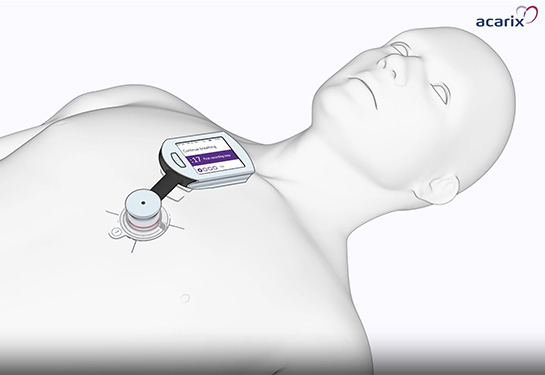Hypertension: The silent killer
Hypertension, also known as high blood pressure, is a serious medical condition in which the blood vessels are pushing against artery walls at a rate higher than they should. Known as “the silent killer,” hypertension can lead to heart attack, stroke and kidney disease.

According to the Centers for Disease Control and Prevention (CDC), nearly half of American adults have hypertension and for nearly 37 million of them, the condition is uncontrolled.
To mark World Hypertension Day 2024, UC Davis Health cardiologist Sandhya Venugopal shares what you need to know about the condition.
How is hypertension diagnosed?
Blood pressure is recorded with two numbers: systolic pressure, which is the force of your heart pumping blood, and diastolic pressure, which is the resistance to blood flow in your blood vessels between heartbeats. Hypertension is when the blood pressure measures 130/80 mm Hg or higher.
The American College of Cardiology and the American Heart Association divide blood pressure into four categories.
- Normal blood pressure: Lower than 120/80 mm Hg
- Elevated blood pressure: The top number ranges from 120 to 129 mm Hg, and the bottom number is below and not above, 80 mm Hg
- Stage 1 hypertension: The top number ranges from 130 to 139 mm Hg or the bottom number is between 80 and 89 mm Hg
- Stage 2 hypertension: The top number is 140 mm Hg or higher, or the bottom number is 90 mm Hg or higher
What are the signs and symptoms of high blood pressure?
Most people who have high blood pressure do not have symptoms. In some cases, they may have a pounding feeling in their head or chest, lightheadedness or dizziness, or other signs. Without symptoms, people with high blood pressure may go years without knowing they have the condition until perhaps they’ve experienced a major health event, thus why it’s called the silent killer.
What are some of the known causes of hypertension?
High blood pressure results from the tightening of very small arteries called arterioles, which regulate blood flow through the body. As these arterioles tighten (or constrict), the heart has to work harder to pump blood through the smaller space, and the pressure inside the vessels grows.
About 90% to 95% of all high blood pressure cases are primary or essential hypertension. That means the real cause of high blood pressure is unknown, but a number of factors contribute.
About 5% to 10% of people with high blood pressure have what is called secondary hypertension, which means the high blood pressure resulted from another condition or illness. Kidney disorders cause many cases of secondary hypertension. Other conditions that can cause secondary hypertension are:
- Problems with the parathyroid gland
- Acromegaly, a disorder in which the pituitary gland makes too much growth hormone
- Tumors in the adrenal or pituitary glands
- Reactions to medicines for other medical problems
- Pregnancy
What can increase your risk of getting high blood pressure?
- Older age
- Genetics
- Being overweight or obese
- Not being physically active
- High-salt diet
- Drinking too much alcohol
Risk factors you can’t control include a family history of hypertension, being over age 65 and co-existing diseases such as diabetes or kidney disease.
Where can you get a blood pressure test?
- At a doctor’s office
- At a pharmacy with a digital blood pressure measurement machine
- At home with an easy-to-use blood pressure monitor kit
How is blood pressure measured?
Your provider will take several blood pressure readings using a device called a sphygmomanometer. Blood pressure is written as two numbers. The first (systolic) number represents the pressure in blood vessels when the heart contracts or beats. The second (diastolic) number represents the pressure in the vessels when the heart rests between beats.
How do you interpret your blood pressure reading?
Most clinicians do not make a final diagnosis of high blood pressure until they measure your blood pressure several times (at least two blood pressure readings on three different days). Some doctors ask their patients to wear a portable device that measures their blood pressure over the course of several days. This machine may help the doctor learn whether a patient has true high blood pressure or what is known as “white-coat hypertension.” That’s a condition in which a patient’s blood pressure rises during a visit to the doctor due to anxiety and stress.
What are the treatments for hypertension?
Lifestyle changes can help lower high blood pressure. These include:
- Eating a healthy, low-salt diet
- Losing weight
- Being physically active
- Quitting tobacco
Your doctor may recommend one or more medicines to treat high blood pressure. Your recommended blood pressure goal may depend on your other health conditions.
Blood pressure goal is less than 130/80 if you have:
- Cardiovascular disease (heart disease or stroke)
- Diabetes (high blood sugar)
- Chronic kidney disease
For most people, the goal is to have a blood pressure less than 140/90.
There are several common blood pressure medicines:
- ACE inhibitors, including enalapril and lisinopril, relax blood vessels and prevent kidney damage
- Angiotensin-2 receptor blockers (ARBs), including losartan and telmisartan, relax blood vessels and prevent kidney damage
- Calcium channel blockers, including amlodipine and felodipine, relax blood vessels
- Diuretics, including hydrochlorothiazide and chlorthalidone, eliminate extra water from the body, lowering blood pressure
When should you see your health care provider for hypertension?
All adults should have their blood pressure checked routinely. It is important to know your numbers. You should check your blood pressure at least every two years starting at age 18. Some people with an increased risk of hypertension may need more frequent checks.




